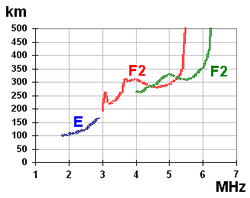Ionosonde


An ionosonde, or chirpsounder, is a special radar for the examination of the ionosphere. The basic ionosonde technology was invented in 1925 by Gregory Breit and Merle A. Tuve [1] and further developed in the late 1920s by a number of prominent physicists, including Edward Victor Appleton. The term ionosphere and hence, the etymology of its derivatives, was proposed by Robert Watson-Watt.
An ionosonde consists of:
- A high frequency (HF) transmitter, automatically tunable over a wide range. Typically the frequency coverage is 0.5–23 MHz or 1–40 MHz, though normally sweeps are confined to approximately 1.6–12 MHz.
- A tracking HF receiver which can automatically track the frequency of the transmitter.
- An antenna with a suitable radiation pattern, which transmits well vertically upwards and is efficient over the whole frequency range used.
- Digital control and data analysis circuits.
The transmitter sweeps all or part of the HF frequency range, transmitting short pulses. These pulses are reflected at various layers of the ionosphere, at heights of 100–400 km, and their echos are received by the receiver and analyzed by the control system. The result is displayed in the form of an ionogram, a graph of reflection height (actually time between transmission and reception of pulse) versus carrier frequency.
An ionosonde is used for finding the optimum operation frequencies for broadcasts or two-way communications in the high frequency range.
See also
References
Further reading
- Davies, Kenneth (1990). Ionospheric Radio. IEE Electromagnetic Waves Series #31. London, UK: Peter Peregrinus Ltd/The Institution of Electrical Engineers. pp. 93–111. ISBN 0-86341-186-X.
- Gwyn Williams, G4FKH (May 2009). "Interpreting Digital Ionograms". RadCom. RSGB. 85 (05): 44–46.
- Breit, G.; Tuve, M.A. (1926). "A Test of the Existence of the Conducting Layer". Physical Review. 28 (3): 554–575. Bibcode:1926PhRv...28..554B. doi:10.1103/PhysRev.28.554.
- Appleton, E. V. (January 1931). "The Timing of Wireless Echoes, the use of television and picture transmission". Wireless World (14): 43–44.
External links
- http://www.ngdc.noaa.gov/stp/iono/ionogram.html : NOAA Ionosonde portal to information and data services
- http://www.ngdc.noaa.gov/stp/IONO/Dynasonde/ : NOAA Dynasonde: Real-time Ionospheric Explorer by advanced and prototype analysis methods.
- http://aintel.bi.ehu.es/chirps-data/chirps.html
- http://ulcar.uml.edu/digisonde.html : Lowell Center for Atmospheric Research, MA, USA
- http://ulcar.uml.edu/stationlist.html : Ionosonde (partial) station list by location
- http://car.uml.edu/common/DIDBFastStationList : DIDBase Fast Station list
- http://www.iono.noa.gr : National Observatoy of Athens, Greece
- http://www.sil.sk.ca/cadi.html : Canadian Advanced Digital Ionosonde (CADI)
